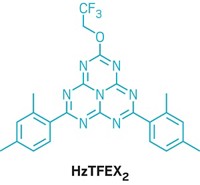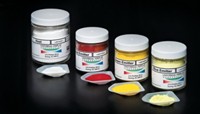Advertisement
Grab your lab coat. Let's get started
Welcome!
Welcome!
Create an account below to get 6 C&EN articles per month, receive newsletters and more - all free.
It seems this is your first time logging in online. Please enter the following information to continue.
As an ACS member you automatically get access to this site. All we need is few more details to create your reading experience.
Not you? Sign in with a different account.
Not you? Sign in with a different account.
ERROR 1
ERROR 1
ERROR 2
ERROR 2
ERROR 2
ERROR 2
ERROR 2
Password and Confirm password must match.
If you have an ACS member number, please enter it here so we can link this account to your membership. (optional)
ERROR 2
ACS values your privacy. By submitting your information, you are gaining access to C&EN and subscribing to our weekly newsletter. We use the information you provide to make your reading experience better, and we will never sell your data to third party members.
Electronic Materials
Your next TV could contain uncommon isotopes
LG is launching organic light-emitting diode displays that contain deuterated compounds
by Alexander H. Tullo
March 6, 2022
| A version of this story appeared in
Volume 100, Issue 9

In December, just before the CES 2022 consumer electronics show in Las Vegas, LG Display unveiled next-generation technology, called OLED.EX, for organic light-emitting diode (OLED) televisions.
At first glance, the advance looked typically prosaic for a trade show rollout of new TV display technology. The company said the technology boosts the “display’s overall picture quality by enhancing brightness up to 30 percent compared to conventional OLED displays.”
But what helped LG achieve that 30% gain is actually something of a chemistry breakthrough. LG, for the first time, acknowledged using a deuterated compound, supplied by DuPont, in the televisions, which will go into mass production in South Korea and China later this year. It’s an advance not only for displays but for the use of deuteration as a way to improve molecules of all kinds.
A deuterated compound is one in which at least one hydrogen has been replaced with its heavier isotope, deuterium. One might not think an extra neutron would significantly change the chemistry of a molecule. But the so-called kinetic isotope effect makes the bonds forged between carbon and deuterium tougher to break than those that bind carbon and mere hydrogen.
For decades, chemists have been trying to exploit the kinetic isotope effect in practical applications. For example, they have been exploring deuterated pharmaceuticals with the aim of slowing metabolic reactions that degrade compounds while leaving efficacy against their targets intact. The result could be lower dosages and fewer side effects.
In 2017, the US Food and Drug Administration approved the first deuterated drug, Teva Pharmaceutical Industries’ Austedo (deutetrabenazine), a treatment for chorea associated with Huntington’s disease.
DuPont researchers wanted to take the idea further. “The extension of the idea that was applied in pharmaceuticals is exactly what we are doing here,” says Norman Herron, a DuPont technical fellow. “We’re keeping the material around longer by changing C-H to C-D.”
Lifetime, Herron explains, is a top consideration for OLED materials. Every pixel in an OLED display is made up of about eight materials stacked in emissive and charge-transport layers. The deterioration of just one of these materials can cause image-sticking problems, ruining the entire display. “What we ultimately do is make sure that we address the weakest material, or the slowest dog on the team, and make sure that it comes up to speed,” Herron says.
For LG’s OLED.EX technology, DuPont deuterated an existing molecule used to carry electrons in the blue-emissive substack. DuPont won’t say what the molecule is other than to classify it as a polyfused aromatic compound. A big synthetic challenge for the DuPont team, which has been working on deuterated OLED compounds for 15 years, was replacing hydrogen with deuterium while maintaining high purity.
“There are multiple carbon-hydrogen bonds in that molecule, and we are substituting some of them but not all of them,” Herron says. “And the net effect is we apparently increased the lifetime. So we must be addressing some of the weaker carbon-hydrogen bonds that were leading to the degradation behavior.”
LG is advertising brighter displays, not televisions that last a long time. That’s because with OLEDs, longevity and brightness have an inverse relationship.
“What you’re doing when you make something run brighter is you’re stressing it harder. You’re running more current through,” Herron says, noting that OLED displays could operate indefinitely if they’re dim enough. By using a more robust material, LG can produce displays that are brighter than the previous generation while lasting just as long.
The OLED.EX technology isn’t the first use of deuteration in LG televisions, Herron says. The electronics maker has dabbled in it before, but OLED.EX is LG’s biggest use of deuterated compounds thus far, and it is the first time the firm has disclosed the compounds’ application.
The use of deuterated compounds isn’t yet widespread in the display industry. “Currently, LG is the only one,” says Jimmy Kim, a senior principal analyst for OLED materials at the technology consulting firm Omdia. Kim notes that DuPont and LG have filed most of the patents for deuterated OLED compounds.
Other groups, however, have investigated deuterium for OLEDs. For example, in 2014, scientists from the University of Tokyo deuterated benzylic methyl groups in a green phosphorescent material. The scientists noted a fivefold increase in material lifetime, while all other properties remained unchanged. The group was also able to achieve higher luminescence from the deuterated compound because it degraded more slowly.
Display firms are pursuing other strategies for maximizing device lifetime, Kim says. For instance, they use tandem structures in which OLED stacks are placed on top of one another, minimizing current density while achieving high light output and long lifetime. Manufacturers have also rolled out materials based on longer-lasting boron dopants, he says.
A bottleneck in the broader use of deuterated compounds in OLEDs is their cost, Kim says. “Due to limited supply chain, its selling price is very high now,” he notes.
Hjalti Skulason, technical manager of the emerging applications group at DuPont Industrial Solutions, acknowledges the issue, which he attributes largely to the additional synthesis steps that are necessary. “Because it is an extra step, it is more expensive than the nondeuterated analogs,” he says.
On top of that, the heavy water (D2O) from which deuterium is derived is quite rare. Deuterium is present in natural water, but at a ratio of 1 deuterium atom for every 6,400 hydrogens. The main commercial application for heavy water is slowing down neutrons in Canada deuterium uranium nuclear reactors. Most heavy water production facilities—which concentrate the water with energy-intensive routes like the Girdler sulfide process—were shut down long ago. Supplies are drawn largely from government stockpiles.
“The deuterium source is certainly going to be a problem we have to solve if it grows really large, but even at full scale—LG TVs being produced with this—it is still not an enormous amount of actual material,” Skulason says. DuPont’s shipments of the deuterated compound now fall in the range of tens to hundreds of kilograms.
Deuterium has the potential to expand the OLED market by making the displays more competitive in the high-performance TV sector, according to Omdia’s Kim. OLED displays have only a 3% share of the television sector, he says, compared with a 30–40% share of the smartphone market. In both cases, liquid crystal displays dominate.
Skulason says the technology could also help OLEDs penetrate into display markets that have thus far been elusive. “I think it’s going to expand into other kinds of more demanding display applications, where there’s more of a static image, and displays that are on for a longer period of time.” Examples include computer monitors and signs. Deuteration, he notes, could also help in automotive displays, which currently have short life spans because of hot summer conditions.
And some future uses of deuterated compounds, Herron says, might not have anything to do with OLEDs at all. “One of the things that we continue to do is look at whether this technology can be applied to non-OLED applications,” he says. “Can deuteration chemistry help us with a lifetime problem somewhere else in the electronic materials world?”




Join the conversation
Contact the reporter
Submit a Letter to the Editor for publication
Engage with us on Twitter